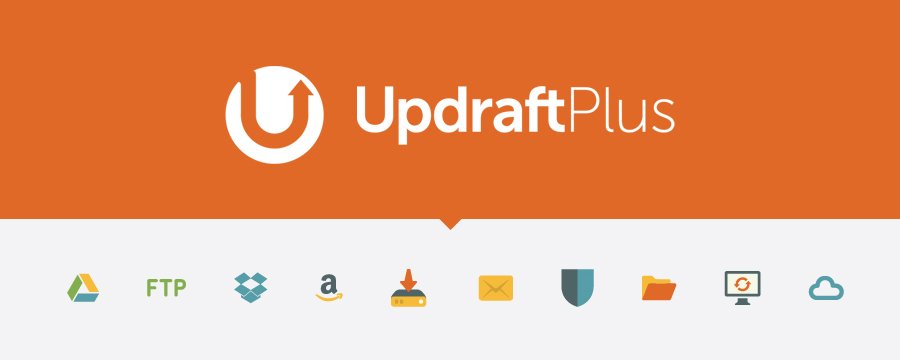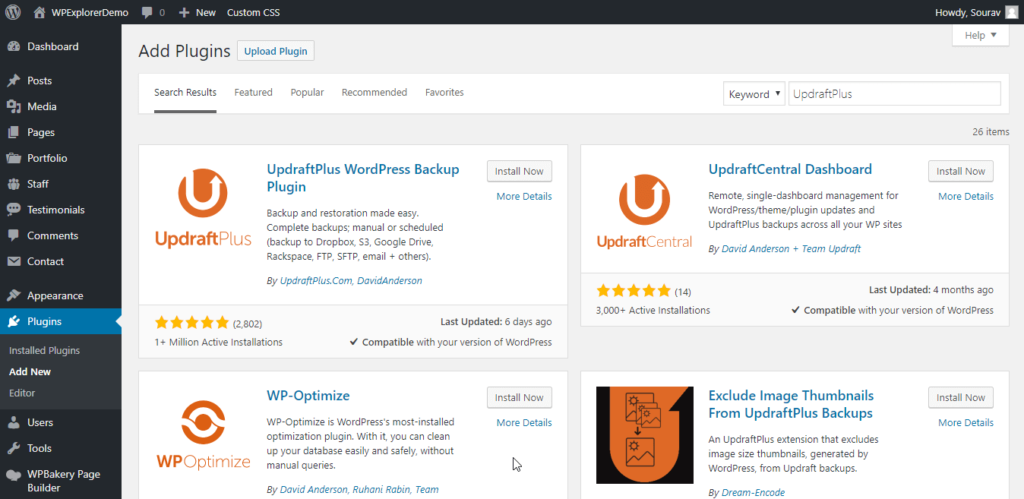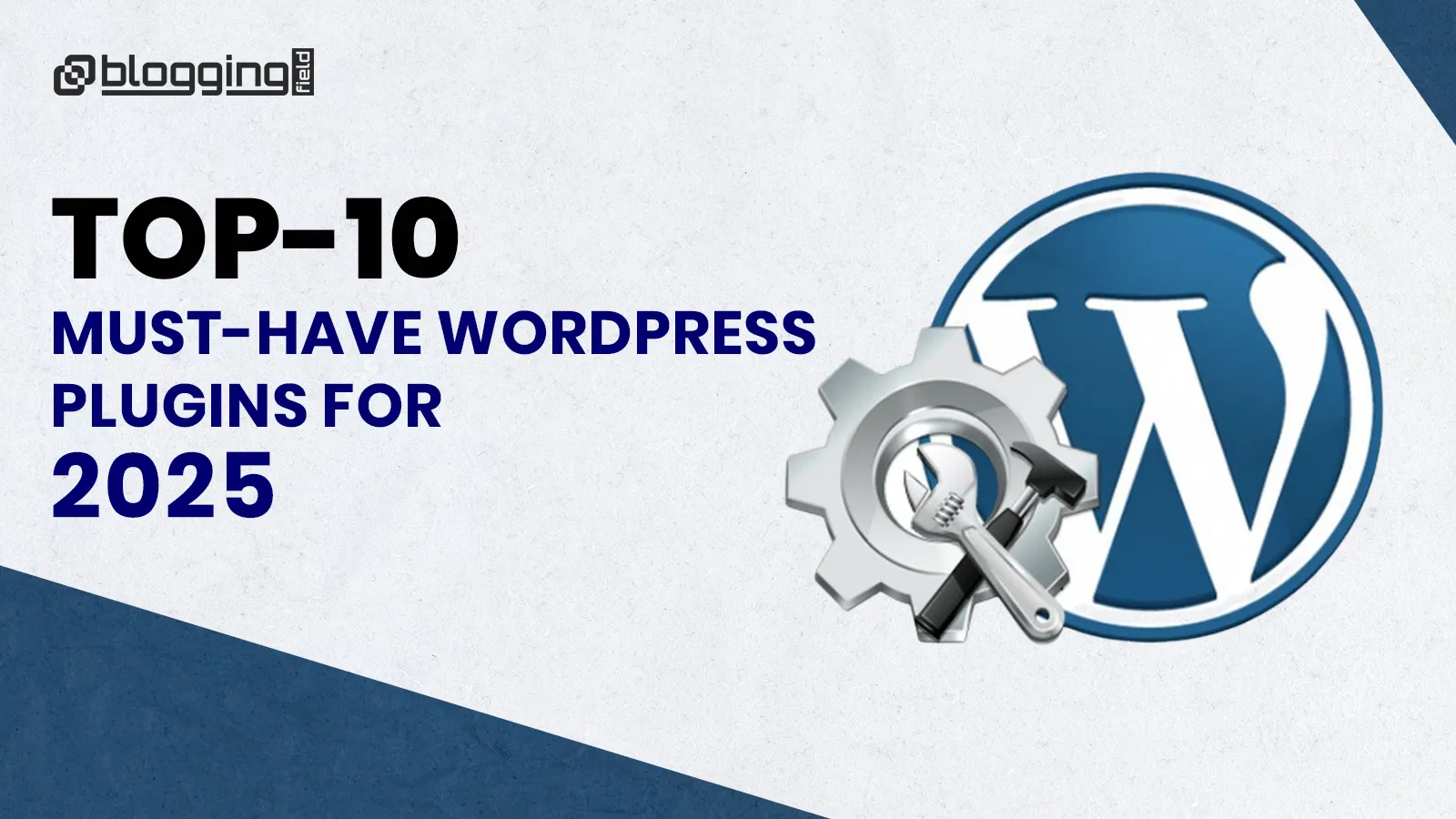Introduction
Hacking, server crashes, dodgy updates or simple user error can ruin your WordPress site. That’s why you need UpdraftPlus, the world’s highest-rated and most installed WordPress backup plugin.
What is UpdraftPlus?

Updraft Plus is a freemium WordPress backup plugin that also allows you to restore, duplicate, and migrate your site in a few clicks, without leaving your administration interface.
With more than 3M+ active installations, Updraft Plus is the most popular backup plugin in the official WordPress directory.It’s effective for all types of sites, from blogs and showcase sites to more complex projects like WooCommerce shops with thousands of products, for example.
It also boasts excellent user reviews, with an overall rating of 4.8/5 out of over 7,000 reviews left at the time of writing.Behind Updraft Plus is the British company Updraft WP, which develops other tools and plugins such as:
• WP-Optimize
• Updraft Central
• All-in-One Security (AIOS)
• WP Overnight
• Internal Link Juicer
For the record, Updraft Plus was launched in 2010 by Paul Kehrer, then quickly abandoned by its creator due to lack of time.Taken over by David Anderson in 2011, it has only continued to grow, and its team has continued to expand.
Why should you use UpdraftPlus?
There are multiple reasons why this plugin has been so successful, according to users:
• It is very easy to use and can be accessed from your WordPress dashboard.
• It requires no technical knowledge for backups or migration. All the options require only a few clicks, on an intuitive interface.
• It’s free version is extensive and comprehensive. You can migrate, restore, and backup your WordPress site without paying a cent!
• You can schedule automatic backups, so you can avoid having to deal with them manually (though you certainly can do it the manual way, if you want).
• You can backup both your site’s files and the database.
• You can save your backups to remote storage spaces in the cloud (Dropbox, Google Drive, Amazon S3, etc.).
• The UpdraftPlus plugin is scalable. The free version will suffice in the majority of cases, but if you want to go farther or benefit from specific options, there are dedicated add-ons and a pro version that are even more comprehensive.
• This backup plugin is also effective for eCommerce sites and multisite networks.
• The plugin is frequently updated and improved, and is managed by a team of about ten people. It’s been around for about ten years, which reassures us of its solidity and commitment to its users.
Why UpdraftPlus?

How much does UpdraftPlus cost?

The free version of UpdraftPlus includes everything you need to make automatic backups of your files and database, as well as to restore or migrate your site.But you should know that there is also a paid version, UpdraftPlus Premium. There are five licenses to choose from, starting at $70/year for use on 2 sites:
Each license includes all the add-ons (complementary plugins) offered by UpdraftPlus, which you can also buy individually.These add-ons allow you to perform the following actions:
• Encryption of your sensitive data for more security
• Backups of all files including the core of WordPress and files outside WordPress
• Incremental backups that allow you to back up only files that have changed since the last backup
• Access to UpdraftVault to store your backup: this is a remote storage space belonging to UpdraftPlus
• Multisite network backups
Cloning and migration of your site with UpdraftPlus Migration (if you have a new host, new domain, etc…)
• Access to more advanced reports
Free version or premium version?
Can’t make up your mind between UpdraftPlus free and Premium? Let’s make a good decision by comparing both versions.
You will notice the following in the paid version:
• Includes more remote storage options
• Supports incrementals
• Offers the capability to backup either your files or the tables of your database
• Provides personal support
• And so much more.
![{"type":"elementor","siteurl":"https://bloggingfield.com/wp-json/","elements":[{"id":"e90a7a3","elType":"widget","isInner":false,"isLocked":false,"settings":{"image":{"url":"https://bloggingfield.com/wp-content/plugins/elementor/assets/images/placeholder.png","id":"","size":""},"image_size":"large","image_custom_dimension":{"width":"","height":""},"caption_source":"none","caption":"","link_to":"none","link":{"url":"","is_external":"","nofollow":"","custom_attributes":""},"open_lightbox":"default","align":"","align_tablet":"","align_mobile":"","width":{"unit":"%","size":"","sizes":[]},"width_tablet":{"unit":"%","size":"","sizes":[]},"width_mobile":{"unit":"%","size":"","sizes":[]},"space":{"unit":"%","size":"","sizes":[]},"space_tablet":{"unit":"%","size":"","sizes":[]},"space_mobile":{"unit":"%","size":"","sizes":[]},"height":{"unit":"px","size":"","sizes":[]},"height_tablet":{"unit":"px","size":"","sizes":[]},"height_mobile":{"unit":"px","size":"","sizes":[]},"object-fit":"","object-fit_tablet":"","object-fit_mobile":"","object-position":"center center","object-position_tablet":"","object-position_mobile":"","opacity":{"unit":"px","size":"","sizes":[]},"css_filters_css_filter":"","css_filters_blur":{"unit":"px","size":0,"sizes":[]},"css_filters_brightness":{"unit":"px","size":100,"sizes":[]},"css_filters_contrast":{"unit":"px","size":100,"sizes":[]},"css_filters_saturate":{"unit":"px","size":100,"sizes":[]},"css_filters_hue":{"unit":"px","size":0,"sizes":[]},"opacity_hover":{"unit":"px","size":"","sizes":[]},"css_filters_hover_css_filter":"","css_filters_hover_blur":{"unit":"px","size":0,"sizes":[]},"css_filters_hover_brightness":{"unit":"px","size":100,"sizes":[]},"css_filters_hover_contrast":{"unit":"px","size":100,"sizes":[]},"css_filters_hover_saturate":{"unit":"px","size":100,"sizes":[]},"css_filters_hover_hue":{"unit":"px","size":0,"sizes":[]},"background_hover_transition":{"unit":"px","size":"","sizes":[]},"hover_animation":"","image_border_border":"","image_border_width":{"unit":"px","top":"","right":"","bottom":"","left":"","isLinked":true},"image_border_width_tablet":{"unit":"px","top":"","right":"","bottom":"","left":"","isLinked":true},"image_border_width_mobile":{"unit":"px","top":"","right":"","bottom":"","left":"","isLinked":true},"image_border_color":"","image_border_radius":{"unit":"px","top":"","right":"","bottom":"","left":"","isLinked":true},"image_border_radius_tablet":{"unit":"px","top":"","right":"","bottom":"","left":"","isLinked":true},"image_border_radius_mobile":{"unit":"px","top":"","right":"","bottom":"","left":"","isLinked":true},"image_box_shadow_box_shadow_type":"","image_box_shadow_box_shadow":{"horizontal":0,"vertical":0,"blur":10,"spread":0,"color":"rgba(0,0,0,0.5)"},"caption_align":"","caption_align_tablet":"","caption_align_mobile":"","text_color":"","caption_background_color":"","caption_typography_typography":"","caption_typography_font_family":"","caption_typography_font_size":{"unit":"px","size":"","sizes":[]},"caption_typography_font_size_tablet":{"unit":"px","size":"","sizes":[]},"caption_typography_font_size_mobile":{"unit":"px","size":"","sizes":[]},"caption_typography_font_weight":"","caption_typography_text_transform":"","caption_typography_font_style":"","caption_typography_text_decoration":"","caption_typography_line_height":{"unit":"px","size":"","sizes":[]},"caption_typography_line_height_tablet":{"unit":"em","size":"","sizes":[]},"caption_typography_line_height_mobile":{"unit":"em","size":"","sizes":[]},"caption_typography_letter_spacing":{"unit":"px","size":"","sizes":[]},"caption_typography_letter_spacing_tablet":{"unit":"px","size":"","sizes":[]},"caption_typography_letter_spacing_mobile":{"unit":"px","size":"","sizes":[]},"caption_typography_word_spacing":{"unit":"px","size":"","sizes":[]},"caption_typography_word_spacing_tablet":{"unit":"em","size":"","sizes":[]},"caption_typography_word_spacing_mobile":{"unit":"em","size":"","sizes":[]},"caption_text_shadow_text_shadow_type":"","caption_text_shadow_text_shadow":{"horizontal":0,"vertical":0,"blur":10,"color":"rgba(0,0,0,0.3)"},"caption_space":{"unit":"px","size":"","sizes":[]},"caption_space_tablet":{"unit":"px","size":"","sizes":[]},"caption_space_mobile":{"unit":"px","size":"","sizes":[]},"_title":"","_margin":{"unit":"px","top":"","right":"","bottom":"","left":"","isLinked":true},"_margin_tablet":{"unit":"px","top":"","right":"","bottom":"","left":"","isLinked":true},"_margin_mobile":{"unit":"px","top":"","right":"","bottom":"","left":"","isLinked":true},"_padding":{"unit":"px","top":"","right":"","bottom":"","left":"","isLinked":true},"_padding_tablet":{"unit":"px","top":"","right":"","bottom":"","left":"","isLinked":true},"_padding_mobile":{"unit":"px","top":"","right":"","bottom":"","left":"","isLinked":true},"_element_width":"","_element_width_tablet":"","_element_width_mobile":"","_element_custom_width":{"unit":"%","size":"","sizes":[]},"_element_custom_width_tablet":{"unit":"px","size":"","sizes":[]},"_element_custom_width_mobile":{"unit":"px","size":"","sizes":[]},"_element_vertical_align":"","_element_vertical_align_tablet":"","_element_vertical_align_mobile":"","_position":"","_offset_orientation_h":"start","_offset_x":{"unit":"px","size":0,"sizes":[]},"_offset_x_tablet":{"unit":"px","size":"","sizes":[]},"_offset_x_mobile":{"unit":"px","size":"","sizes":[]},"_offset_x_end":{"unit":"px","size":0,"sizes":[]},"_offset_x_end_tablet":{"unit":"px","size":"","sizes":[]},"_offset_x_end_mobile":{"unit":"px","size":"","sizes":[]},"_offset_orientation_v":"start","_offset_y":{"unit":"px","size":0,"sizes":[]},"_offset_y_tablet":{"unit":"px","size":"","sizes":[]},"_offset_y_mobile":{"unit":"px","size":"","sizes":[]},"_offset_y_end":{"unit":"px","size":0,"sizes":[]},"_offset_y_end_tablet":{"unit":"px","size":"","sizes":[]},"_offset_y_end_mobile":{"unit":"px","size":"","sizes":[]},"_z_index":"","_z_index_tablet":"","_z_index_mobile":"","_element_id":"","_css_classes":"","e_display_conditions":"","_element_cache":"","motion_fx_motion_fx_scrolling":"","motion_fx_translateY_effect":"","motion_fx_translateY_direction":"","motion_fx_translateY_speed":{"unit":"px","size":4,"sizes":[]},"motion_fx_translateY_affectedRange":{"unit":"%","size":"","sizes":{"start":0,"end":100}},"motion_fx_translateX_effect":"","motion_fx_translateX_direction":"","motion_fx_translateX_speed":{"unit":"px","size":4,"sizes":[]},"motion_fx_translateX_affectedRange":{"unit":"%","size":"","sizes":{"start":0,"end":100}},"motion_fx_opacity_effect":"","motion_fx_opacity_direction":"out-in","motion_fx_opacity_level":{"unit":"px","size":10,"sizes":[]},"motion_fx_opacity_range":{"unit":"%","size":"","sizes":{"start":20,"end":80}},"motion_fx_blur_effect":"","motion_fx_blur_direction":"out-in","motion_fx_blur_level":{"unit":"px","size":7,"sizes":[]},"motion_fx_blur_range":{"unit":"%","size":"","sizes":{"start":20,"end":80}},"motion_fx_rotateZ_effect":"","motion_fx_rotateZ_direction":"","motion_fx_rotateZ_speed":{"unit":"px","size":1,"sizes":[]},"motion_fx_rotateZ_affectedRange":{"unit":"%","size":"","sizes":{"start":0,"end":100}},"motion_fx_scale_effect":"","motion_fx_scale_direction":"out-in","motion_fx_scale_speed":{"unit":"px","size":4,"sizes":[]},"motion_fx_scale_range":{"unit":"%","size":"","sizes":{"start":20,"end":80}},"motion_fx_transform_origin_x":"center","motion_fx_transform_origin_y":"center","motion_fx_devices":["desktop","tablet","mobile"],"motion_fx_range":"","motion_fx_motion_fx_mouse":"","motion_fx_mouseTrack_effect":"","motion_fx_mouseTrack_direction":"","motion_fx_mouseTrack_speed":{"unit":"px","size":1,"sizes":[]},"motion_fx_tilt_effect":"","motion_fx_tilt_direction":"","motion_fx_tilt_speed":{"unit":"px","size":4,"sizes":[]},"handle_motion_fx_asset_loading":"","sticky":"","sticky_on":["desktop","tablet","mobile"],"sticky_offset":0,"sticky_offset_tablet":"","sticky_offset_mobile":"","sticky_effects_offset":0,"sticky_effects_offset_tablet":"","sticky_effects_offset_mobile":"","sticky_anchor_link_offset":0,"sticky_anchor_link_offset_tablet":"","sticky_anchor_link_offset_mobile":"","sticky_parent":"","_animation":"","_animation_tablet":"","_animation_mobile":"","animation_duration":"","_animation_delay":"","_transform_rotate_popover":"","_transform_rotateZ_effect":{"unit":"px","size":"","sizes":[]},"_transform_rotateZ_effect_tablet":{"unit":"deg","size":"","sizes":[]},"_transform_rotateZ_effect_mobile":{"unit":"deg","size":"","sizes":[]},"_transform_rotate_3d":"","_transform_rotateX_effect":{"unit":"px","size":"","sizes":[]},"_transform_rotateX_effect_tablet":{"unit":"deg","size":"","sizes":[]},"_transform_rotateX_effect_mobile":{"unit":"deg","size":"","sizes":[]},"_transform_rotateY_effect":{"unit":"px","size":"","sizes":[]},"_transform_rotateY_effect_tablet":{"unit":"deg","size":"","sizes":[]},"_transform_rotateY_effect_mobile":{"unit":"deg","size":"","sizes":[]},"_transform_perspective_effect":{"unit":"px","size":"","sizes":[]},"_transform_perspective_effect_tablet":{"unit":"px","size":"","sizes":[]},"_transform_perspective_effect_mobile":{"unit":"px","size":"","sizes":[]},"_transform_translate_popover":"","_transform_translateX_effect":{"unit":"px","size":"","sizes":[]},"_transform_translateX_effect_tablet":{"unit":"px","size":"","sizes":[]},"_transform_translateX_effect_mobile":{"unit":"px","size":"","sizes":[]},"_transform_translateY_effect":{"unit":"px","size":"","sizes":[]},"_transform_translateY_effect_tablet":{"unit":"px","size":"","sizes":[]},"_transform_translateY_effect_mobile":{"unit":"px","size":"","sizes":[]},"_transform_scale_popover":"","_transform_keep_proportions":"yes","_transform_scale_effect":{"unit":"px","size":"","sizes":[]},"_transform_scale_effect_tablet":{"unit":"px","size":"","sizes":[]},"_transform_scale_effect_mobile":{"unit":"px","size":"","sizes":[]},"_transform_scaleX_effect":{"unit":"px","size":"","sizes":[]},"_transform_scaleX_effect_tablet":{"unit":"px","size":"","sizes":[]},"_transform_scaleX_effect_mobile":{"unit":"px","size":"","sizes":[]},"_transform_scaleY_effect":{"unit":"px","size":"","sizes":[]},"_transform_scaleY_effect_tablet":{"unit":"px","size":"","sizes":[]},"_transform_scaleY_effect_mobile":{"unit":"px","size":"","sizes":[]},"_transform_skew_popover":"","_transform_skewX_effect":{"unit":"px","size":"","sizes":[]},"_transform_skewX_effect_tablet":{"unit":"deg","size":"","sizes":[]},"_transform_skewX_effect_mobile":{"unit":"deg","size":"","sizes":[]},"_transform_skewY_effect":{"unit":"px","size":"","sizes":[]},"_transform_skewY_effect_tablet":{"unit":"deg","size":"","sizes":[]},"_transform_skewY_effect_mobile":{"unit":"deg","size":"","sizes":[]},"_transform_flipX_effect":"","_transform_flipY_effect":"","_transform_rotate_popover_hover":"","_transform_rotateZ_effect_hover":{"unit":"px","size":"","sizes":[]},"_transform_rotateZ_effect_hover_tablet":{"unit":"deg","size":"","sizes":[]},"_transform_rotateZ_effect_hover_mobile":{"unit":"deg","size":"","sizes":[]},"_transform_rotate_3d_hover":"","_transform_rotateX_effect_hover":{"unit":"px","size":"","sizes":[]},"_transform_rotateX_effect_hover_tablet":{"unit":"deg","size":"","sizes":[]},"_transform_rotateX_effect_hover_mobile":{"unit":"deg","size":"","sizes":[]},"_transform_rotateY_effect_hover":{"unit":"px","size":"","sizes":[]},"_transform_rotateY_effect_hover_tablet":{"unit":"deg","size":"","sizes":[]},"_transform_rotateY_effect_hover_mobile":{"unit":"deg","size":"","sizes":[]},"_transform_perspective_effect_hover":{"unit":"px","size":"","sizes":[]},"_transform_perspective_effect_hover_tablet":{"unit":"px","size":"","sizes":[]},"_transform_perspective_effect_hover_mobile":{"unit":"px","size":"","sizes":[]},"_transform_translate_popover_hover":"","_transform_translateX_effect_hover":{"unit":"px","size":"","sizes":[]},"_transform_translateX_effect_hover_tablet":{"unit":"px","size":"","sizes":[]},"_transform_translateX_effect_hover_mobile":{"unit":"px","size":"","sizes":[]},"_transform_translateY_effect_hover":{"unit":"px","size":"","sizes":[]},"_transform_translateY_effect_hover_tablet":{"unit":"px","size":"","sizes":[]},"_transform_translateY_effect_hover_mobile":{"unit":"px","size":"","sizes":[]},"_transform_scale_popover_hover":"","_transform_keep_proportions_hover":"yes","_transform_scale_effect_hover":{"unit":"px","size":"","sizes":[]},"_transform_scale_effect_hover_tablet":{"unit":"px","size":"","sizes":[]},"_transform_scale_effect_hover_mobile":{"unit":"px","size":"","sizes":[]},"_transform_scaleX_effect_hover":{"unit":"px","size":"","sizes":[]},"_transform_scaleX_effect_hover_tablet":{"unit":"px","size":"","sizes":[]},"_transform_scaleX_effect_hover_mobile":{"unit":"px","size":"","sizes":[]},"_transform_scaleY_effect_hover":{"unit":"px","size":"","sizes":[]},"_transform_scaleY_effect_hover_tablet":{"unit":"px","size":"","sizes":[]},"_transform_scaleY_effect_hover_mobile":{"unit":"px","size":"","sizes":[]},"_transform_skew_popover_hover":"","_transform_skewX_effect_hover":{"unit":"px","size":"","sizes":[]},"_transform_skewX_effect_hover_tablet":{"unit":"deg","size":"","sizes":[]},"_transform_skewX_effect_hover_mobile":{"unit":"deg","size":"","sizes":[]},"_transform_skewY_effect_hover":{"unit":"px","size":"","sizes":[]},"_transform_skewY_effect_hover_tablet":{"unit":"deg","size":"","sizes":[]},"_transform_skewY_effect_hover_mobile":{"unit":"deg","size":"","sizes":[]},"_transform_flipX_effect_hover":"","_transform_flipY_effect_hover":"","_transform_transition_hover":{"unit":"px","size":"","sizes":[]},"motion_fx_transform_x_anchor_point":"","motion_fx_transform_x_anchor_point_tablet":"","motion_fx_transform_x_anchor_point_mobile":"","motion_fx_transform_y_anchor_point":"","motion_fx_transform_y_anchor_point_tablet":"","motion_fx_transform_y_anchor_point_mobile":"","_background_background":"","_background_color":"","_background_color_stop":{"unit":"%","size":0,"sizes":[]},"_background_color_stop_tablet":{"unit":"%"},"_background_color_stop_mobile":{"unit":"%"},"_background_color_b":"#f2295b","_background_color_b_stop":{"unit":"%","size":100,"sizes":[]},"_background_color_b_stop_tablet":{"unit":"%"},"_background_color_b_stop_mobile":{"unit":"%"},"_background_gradient_type":"linear","_background_gradient_angle":{"unit":"deg","size":180,"sizes":[]},"_background_gradient_angle_tablet":{"unit":"deg"},"_background_gradient_angle_mobile":{"unit":"deg"},"_background_gradient_position":"center center","_background_gradient_position_tablet":"","_background_gradient_position_mobile":"","_background_image":{"url":"","id":"","size":""},"_background_image_tablet":{"url":"","id":"","size":""},"_background_image_mobile":{"url":"","id":"","size":""},"_background_position":"","_background_position_tablet":"","_background_position_mobile":"","_background_xpos":{"unit":"px","size":0,"sizes":[]},"_background_xpos_tablet":{"unit":"px","size":0,"sizes":[]},"_background_xpos_mobile":{"unit":"px","size":0,"sizes":[]},"_background_ypos":{"unit":"px","size":0,"sizes":[]},"_background_ypos_tablet":{"unit":"px","size":0,"sizes":[]},"_background_ypos_mobile":{"unit":"px","size":0,"sizes":[]},"_background_attachment":"","_background_repeat":"","_background_repeat_tablet":"","_background_repeat_mobile":"","_background_size":"","_background_size_tablet":"","_background_size_mobile":"","_background_bg_width":{"unit":"%","size":100,"sizes":[]},"_background_bg_width_tablet":{"unit":"px","size":"","sizes":[]},"_background_bg_width_mobile":{"unit":"px","size":"","sizes":[]},"_background_video_link":"","_background_video_start":"","_background_video_end":"","_background_play_once":"","_background_play_on_mobile":"","_background_privacy_mode":"","_background_video_fallback":{"url":"","id":"","size":""},"_background_slideshow_gallery":[],"_background_slideshow_loop":"yes","_background_slideshow_slide_duration":5000,"_background_slideshow_slide_transition":"fade","_background_slideshow_transition_duration":500,"_background_slideshow_background_size":"","_background_slideshow_background_size_tablet":"","_background_slideshow_background_size_mobile":"","_background_slideshow_background_position":"","_background_slideshow_background_position_tablet":"","_background_slideshow_background_position_mobile":"","_background_slideshow_lazyload":"","_background_slideshow_ken_burns":"","_background_slideshow_ken_burns_zoom_direction":"in","_background_hover_background":"","_background_hover_color":"","_background_hover_color_stop":{"unit":"%","size":0,"sizes":[]},"_background_hover_color_stop_tablet":{"unit":"%"},"_background_hover_color_stop_mobile":{"unit":"%"},"_background_hover_color_b":"#f2295b","_background_hover_color_b_stop":{"unit":"%","size":100,"sizes":[]},"_background_hover_color_b_stop_tablet":{"unit":"%"},"_background_hover_color_b_stop_mobile":{"unit":"%"},"_background_hover_gradient_type":"linear","_background_hover_gradient_angle":{"unit":"deg","size":180,"sizes":[]},"_background_hover_gradient_angle_tablet":{"unit":"deg"},"_background_hover_gradient_angle_mobile":{"unit":"deg"},"_background_hover_gradient_position":"center center","_background_hover_gradient_position_tablet":"","_background_hover_gradient_position_mobile":"","_background_hover_image":{"url":"","id":"","size":""},"_background_hover_image_tablet":{"url":"","id":"","size":""},"_background_hover_image_mobile":{"url":"","id":"","size":""},"_background_hover_position":"","_background_hover_position_tablet":"","_background_hover_position_mobile":"","_background_hover_xpos":{"unit":"px","size":0,"sizes":[]},"_background_hover_xpos_tablet":{"unit":"px","size":0,"sizes":[]},"_background_hover_xpos_mobile":{"unit":"px","size":0,"sizes":[]},"_background_hover_ypos":{"unit":"px","size":0,"sizes":[]},"_background_hover_ypos_tablet":{"unit":"px","size":0,"sizes":[]},"_background_hover_ypos_mobile":{"unit":"px","size":0,"sizes":[]},"_background_hover_attachment":"","_background_hover_repeat":"","_background_hover_repeat_tablet":"","_background_hover_repeat_mobile":"","_background_hover_size":"","_background_hover_size_tablet":"","_background_hover_size_mobile":"","_background_hover_bg_width":{"unit":"%","size":100,"sizes":[]},"_background_hover_bg_width_tablet":{"unit":"px","size":"","sizes":[]},"_background_hover_bg_width_mobile":{"unit":"px","size":"","sizes":[]},"_background_hover_video_link":"","_background_hover_video_start":"","_background_hover_video_end":"","_background_hover_play_once":"","_background_hover_play_on_mobile":"","_background_hover_privacy_mode":"","_background_hover_video_fallback":{"url":"","id":"","size":""},"_background_hover_slideshow_gallery":[],"_background_hover_slideshow_loop":"yes","_background_hover_slideshow_slide_duration":5000,"_background_hover_slideshow_slide_transition":"fade","_background_hover_slideshow_transition_duration":500,"_background_hover_slideshow_background_size":"","_background_hover_slideshow_background_size_tablet":"","_background_hover_slideshow_background_size_mobile":"","_background_hover_slideshow_background_position":"","_background_hover_slideshow_background_position_tablet":"","_background_hover_slideshow_background_position_mobile":"","_background_hover_slideshow_lazyload":"","_background_hover_slideshow_ken_burns":"","_background_hover_slideshow_ken_burns_zoom_direction":"in","_background_hover_transition":{"unit":"px","size":"","sizes":[]},"_border_border":"","_border_width":{"unit":"px","top":"","right":"","bottom":"","left":"","isLinked":true},"_border_width_tablet":{"unit":"px","top":"","right":"","bottom":"","left":"","isLinked":true},"_border_width_mobile":{"unit":"px","top":"","right":"","bottom":"","left":"","isLinked":true},"_border_color":"","_border_radius":{"unit":"px","top":"","right":"","bottom":"","left":"","isLinked":true},"_border_radius_tablet":{"unit":"px","top":"","right":"","bottom":"","left":"","isLinked":true},"_border_radius_mobile":{"unit":"px","top":"","right":"","bottom":"","left":"","isLinked":true},"_box_shadow_box_shadow_type":"","_box_shadow_box_shadow":{"horizontal":0,"vertical":0,"blur":10,"spread":0,"color":"rgba(0,0,0,0.5)"},"_box_shadow_box_shadow_position":" ","_border_hover_border":"","_border_hover_width":{"unit":"px","top":"","right":"","bottom":"","left":"","isLinked":true},"_border_hover_width_tablet":{"unit":"px","top":"","right":"","bottom":"","left":"","isLinked":true},"_border_hover_width_mobile":{"unit":"px","top":"","right":"","bottom":"","left":"","isLinked":true},"_border_hover_color":"","_border_radius_hover":{"unit":"px","top":"","right":"","bottom":"","left":"","isLinked":true},"_border_radius_hover_tablet":{"unit":"px","top":"","right":"","bottom":"","left":"","isLinked":true},"_border_radius_hover_mobile":{"unit":"px","top":"","right":"","bottom":"","left":"","isLinked":true},"_box_shadow_hover_box_shadow_type":"","_box_shadow_hover_box_shadow":{"horizontal":0,"vertical":0,"blur":10,"spread":0,"color":"rgba(0,0,0,0.5)"},"_box_shadow_hover_box_shadow_position":" ","_border_hover_transition":{"unit":"px","size":"","sizes":[]},"_mask_switch":"","_mask_shape":"circle","_mask_image":{"url":"","id":"","size":""},"_mask_notice":"","_mask_size":"contain","_mask_size_tablet":"","_mask_size_mobile":"","_mask_size_scale":{"unit":"%","size":100,"sizes":[]},"_mask_size_scale_tablet":{"unit":"px","size":"","sizes":[]},"_mask_size_scale_mobile":{"unit":"px","size":"","sizes":[]},"_mask_position":"center center","_mask_position_tablet":"","_mask_position_mobile":"","_mask_position_x":{"unit":"%","size":0,"sizes":[]},"_mask_position_x_tablet":{"unit":"px","size":"","sizes":[]},"_mask_position_x_mobile":{"unit":"px","size":"","sizes":[]},"_mask_position_y":{"unit":"%","size":0,"sizes":[]},"_mask_position_y_tablet":{"unit":"px","size":"","sizes":[]},"_mask_position_y_mobile":{"unit":"px","size":"","sizes":[]},"_mask_repeat":"no-repeat","_mask_repeat_tablet":"","_mask_repeat_mobile":"","hide_desktop":"","hide_tablet":"","hide_mobile":"","_attributes":"","custom_css":""},"defaultEditSettings":{"defaultEditRoute":"content"},"elements":[],"widgetType":"image","editSettings":{"defaultEditRoute":"content","panel":{"activeTab":"content","activeSection":"section_image"}},"htmlCache":""}]}](https://bloggingfield.com/wp-content/uploads/2025/01/updraftplus-premium-comparison-623x1024.webp)
How to backup a WordPress site with UpdraftPlus
The plugin only backs up YOUR content, i.e. your theme, media, and plugins (the contents of the /wp-content/ folder on your server) and your database. It does not back up WordPress core files. If you want to back up everything, you’ll need to purchase a paid add-on.
Step 1: Install and activate the plugin
To begin, install and activate UpdraftPlus on your administration interface. In the Plugins > Add New menu, type UpdraftPlus in the search bar.
Then click on the “Install now” and “Activate” buttons:

Once the plugin is active, you’ll find all its options in the Settings > UpdraftPlus Backups menu.
You’ll then land on the UpdraftPlus dashboard, comprising 5 main tabs:
• Backup/Restore: To make a backup or restore one, view the next scheduled backups, and access the latest backups.
• Migrate/Clone: To create a temporary copy of your site or to migrate it (to another host for example).
• Settings: To set up backup operations, their contents, and remote storage space.
• Advanced Tools: Overview of paid features and technical information on your site; these are useful if you need support.
• Premium/Extensions: Overview of all the paid features of the plugin and incentive to subscribe to it.
Okay, let’s not waste time and let’s go to the setup. To do that, go to the “Settings” tab.
Step 2: Schedule backups
To begin with, you will be able to decide whether or not to automate backups of your files (which is highly recommended).
Here you have the choice between Manual or or select a periodicity for automatic backups (hourly, daily, weekly, monthly, etc.).
In Manual, you decide when you make your backups. This is very useful before a big update or an important intervention, but it has the disadvantage of forcing you to repeat the operation regularly.
So you must not forget to implement automation. To do this, define the backup periodicity for:
• Site files (i.e. themes, plugins, media, etc.)
• Databases (where your contents, settings, and user accounts are stored)
• As well as the number of backups to keep in your storage space. The default setting is 2. That means that the third backup completed will replace the first one, and so on. Some advice: don’t keep too many backups, as it can slow down the loading speed of your page.
Either you decide to perform these backups at the same time or you program them independently.
If you write a lot of articles on your blog, it may be useful to back up the database on a daily basis while a weekly backup will be sufficient for the other files. So it really just depends on how you use your site.
In any case with automation, you don’t have to think about backup operations anymore since the plugin takes care of everything.
Don’t forget to save the settings before setting up your remote storage space. Otherwise you will have to start again. To do so, click on the button “Save changes,” in the top left of the settings page.
Step 3: Choose a remote storage space
Here you will find another advantage of UpdraftPlus: the plugin allows you to connect to different storage spaces in order to automatically send a copy of your backups there.
If you do not select any remote storage, the backup will be stored only on your server. And if your server gets hacked, the hacker will have access to the backup and will be able to delete it at will. In this case, your backup is useless…
There is also an option to have a copy sent to you by email, but I don’t recommend it since the weight of the backup is often way too heavy, and therefore the message will be refused by your inbox.
To validate the choice of remote storage, select it. Then it will be necessary to authenticate to the service and authorize UpdraftPlus to come and drop the files (Dropbox in my case).
Once authenticated, save the settings again so that UpdraftPlus takes into account the configured remote storage space.
Step 4: Choose the elements to include in the backup
The next step is to define the components that will be copied to the backup. Here, it’s best to leave all the default settings.

As mentioned above, UpdraftPlus only backs up what is specific to your site: database, media, plugins and themes. It does not back up files from your WordPress installation.
If your site has a problem with this, restoring your own content will not help. You will need to do a full reinstall first.Here you can see that will be included in the backup:
• Plugins
• Themes
• Uploads: uploaded media
• And any other directory specific to your site in the /wp-content/ folder
Then, the plugin will exclude some unnecessary components such as its previous backups or the cache.You can also add exclusions according to the plugins you use on your site (click on the link “Add an exclusion rule” for that).
Step 5: Activate advanced settings
Next, UpdraftPlus gives you three additional options:
1.Encryption of database: This is an option available in the paid version of the plugin that allows you to encrypt your database backups to make them more secure.
2.Email: You can receive a report of each backup by email by checking this box. This action allows you to know when backups are made and to monitor in case of problems. To avoid cluttering your inbox unnecessarily, leave the box unchecked.
3.Advanced settings: Finally, there is an area dedicated to advanced settings, including the size for splitting archives, deleting local backups, and the name of the backup directory. The default configuration here is sufficient and we won’t go into detail about these advanced settings in this tutorial. However, if you want to know more, you can check out the whole plugin documentation.
Finally, don’t forget to save your settings.Congratulations, you have finished setting up UpdraftPlus!
Step 6: Backup your site
To finally get down to business and make your first backup, leave the “Settings” tab and return to the plugin’s home page, i.e. to the “Backup/Restore” tab.
One more click, and your next backup will be ready.
How do you backup automatically?
If you have chosen automated backups, the first box displays the date and time of the next backup of the files and the database.
You can do nothing more than let the plugin do the backup automatically at the indicated date and time.You don’t need to stay on the plugin page or reopen it for the backup to take place. UpdraftPlus takes care of it in the background.
How do you backup manually with UpdraftPlus? However, at any time, you can decide to make a manual backup yourself by clicking on the big blue “Backup Now” button.
This action can be very useful before making a big update or an important modification on your site.
A popup appears to validate your settings on the files to include and the remote storage space chosen (these are the same settings you made previously in the “Settings” tab, so you don’t have to do anything more here).
If everything looks OK, just click on the “Backup Now” button at the bottom of this window and let’s go!A progress bar appears to detail the status of the backup. Just wait until it is complete.
Be careful: for large sites, if the backup process takes too long, it may be blocked by the server (timeout). It may be necessary to ask your hosting provider to increase the processing time in order to successfully complete this operation.
If you use Bluehost (affiliate link), you will not have this problem.However, this is still quite rare because UpdraftPlus independently backs up each component of your site.
Once the backup is complete, the last log message is displayed in a new box in the middle of the page to indicate either a successful backup or an error message if there was a problem.The last backup is displayed at the bottom of the screen in the “Existing Backups” section. Various information is included:
• Date and time of the backup
• Buttons to download the saved data: database, plugins, themes, uploads, etc.
• The option to restore, delete, or view the log for a backup
Step 7: Check the backup
Once the backup has been successfully completed, you can verify that the backup is present on your remote storage space.If like me you use Dropbox, go to Applications > UpdraftPlus.com.The latter does not consist of a single .zip file but of 5 files, which correspond to the:
• Themes
• Plugins
• Media
• Database
• Others files from /wp-content/
Congratulations! You have successfully completed your first backup as well as the automation of the next ones!
Conclusion
UpdraftPlus is now one of the most widely used plugins within WordPress. Firstly, because it’s very inclusive. You get to back up, restore and even migrate your site free.Secondly, because it is very easy to use. The setup for backing up using this plugin doesn’t require special technical knowledge.You get it now: making backups of your website is very important!
On the web, all sites are at risk, regardless of their popularity and content. A bad manipulation, a hack, an update that fails… and in a split second your site can disappear.
After setting a couple of things, the rest is handled by the plugin. Your backups are scheduled automatically and you won’t need to think about it anymore.Be it the smallest or largest site, UpdraftPlus can back it up (and restore/migrate) without flinching.
Frequently Asked Questions (FAQs)
Where does WordPress UpdraftPlus backup?
wp-content directory
Your backups are stored on your hosting server within a folder called “UpdraftPlus” in the wp-content directory. You can lose access to your backup files in the event that your hosting provider experiences a problem, like a server breakdown or crash.
What is UpdraftPlus?
UpdraftPlus is one of the few free plugins that can restore a website from backups within the WordPress Admin. Its free version also offers a range of remote storage options, including Dropbox, Google Drive, FTP, Rackspace, and email.
What file type is UpdraftPlus?
UpdraftPlus backs up your files into ordinary zip files (the same format that WordPress and its plugins and theme directories use) rather than any proprietary file formats. The database is backed up into an ordinary SQL (text) file. Therefore you can use UpdraftPlus to restore backups, but do not have to.










